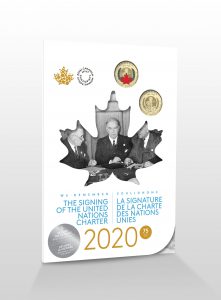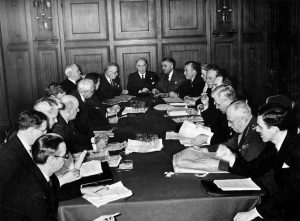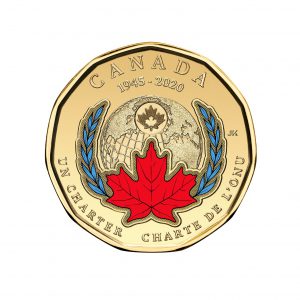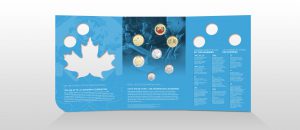Almost 75 years after its creation, the United Nations (UN) is being remembered on the Royal Canadian Mint’s first coloured $1 circulation coin, which was unveiled today by the Crown corporation.
The signature UN blue – one of two official UN colours along with white – is featured alongside the iconic red maple leaf to create a tribute to Canada’s “enduring commitment to international co-operation,” according to a statement issued today by the Mint. The coin marks the 75th anniversary of the Charter of the United Nations, a 1945 treaty signed by 51 nations, including Canada, in the aftermath of the Second World War. The signatories aimed to establish a new world body with four fundamental goals—to save succeeding generations from the scourge of war; champion human rights; foster respect for international law and treaties; and promote social progress.
The treaty came into effect on Oct. 24, 1945, following ratification by the original five permanent members of the UN Security Council (the United States, the United Kingdom, China, France and the Soviet Union) plus a majority of the other signatories, including Canada. Oct. 24 was later declared as United Nations Day by the UN General Assembly.
“The Mint is proud to celebrate Canada’s history, culture and values through coins that find millions of Canadians, and we are pleased to share the important story of Canada’s role in founding the United Nations 75 years ago,” said Mintmaster Marie Lemay, who has been the Crown corporation’s president and CEO since February 2019.
“We are honoured and excited to shine a bright light on a moment when founding members of the United Nations chose to move forward with a promise of international co-operation, peace and security by colouring a $1 circulation coin for the very first time.”
Canadians are “proud of our leadership within this institution to make our world more just and peaceful,” said Karina Gould, Canada’s federal international development minister.
“As the Mint’s special $1 coin circulates from coast to coast to coast, the Government of Canada hopes it will stand as a symbol of the continuing importance of the United Nations and of our nation’s enduring belief in international co-operation,” added Gould.
The coin was unveiled this morning via the Mint’s YouTube channel. Watch the unveiling by clicking below.
COLOURED, UNCOLOURED VERSIONS
The coin’s reverse is designed by artist Joel Kimmel, of Westport, Ont.
In a nod to the UN logo, a world map within an olive branch wreath is paired with a maple leaf to symbolize Canada’s commitment to the UN and its values. This central design is framed by a “1945-2020” double date and the words “UN CHARTER” and “CHARTE DE L’ONU” along the edge.
Two million coloured coins, with a red maple leaf and olive branches in the same shade of blue as the UN flag, are entering circulation today.

A collector keepsake set features both versions of the commemorative circulation coin packaged with uncirculated versions of Canada’s 2020 classic circulation coins.
An uncoloured version limited to one million coins is also available.
The obverse of both versions features the effigy of Queen Elizabeth II designed by Canadian artist Susanna Blunt in 2003.
The Mint also issued a collector keepsake set featuring both versions of the commemorative circulation coin packaged with uncirculated versions of Canada’s 2020 classic circulation coins (five cents through $2). There’s a mintage of 100,000 sets.
The coins were also initially slated to be issued in rolls; however, the rolls were cancelled by the Mint. More details about the cancellation are forthcoming.
Alex Reeves, senior manager of public affairs, told CCN the rolls were cancelled because of “unforeseen circumstances affecting one of many factors involved in bringing a new product to market.”
“The Mint regrets the inconvenience to collectors who were hoping to purchase this kind of product,” he added.
UN HISTORY
The first official use of the name “United Nations” appeared in the Declaration by United Nations signed by 26 signatories – Canada among them – on Jan. 1, 1942.
This precursor to the UN Charter (also known as the “Atlantic Charter”) was the product of a secret meeting between U.S. President Franklin D. Roosevelt and British Prime Minister Winston Churchill off the coast of Ship Harbour, N.L., in Placentia Bay.
Three years later, during the April-June 1945 “San Francisco Conference,” which involved most of the world’s sovereign nations, the UN Charter was discussed, prepared and drafted. Following a two-thirds approval of each part, the final text was unanimously adopted by the conference delegates and opened for signature on June 26 of that year at the San Francisco War Memorial and Performing Arts Center in California.
“This historic moment created the United Nations, an international organization that promotes co-operation, dialogue and peace around the world—a mission it held in 1945 and still does today,” said Prime Minister Justin Trudeau this June, when he marked the anniversary of the charter’s signing.
“As the world grappled with the harsh lessons of the Second World War, people representing over 80 per cent of the global population – and the diversity of the human family – gathered in San Francisco to sign the UN Charter and create an organization that would help build a better world.”
In 1948, three years after the charter’s signing, the UN General Assembly formally adopted the Universal Declaration of Human Rights, the first draft of which was written by Canada’s John Peters Humphrey.
In 1957, former Canadian prime minister Lester B. Pearson won the Nobel Peace Prize for proposing the creation of a UN peacekeeping force. Since 1956, Canada has undertaken nearly 40 major UN “peace support operations,” the most recent of which was in Afghanistan from 2001-14.
Canada has served six terms as a non-permanent member of the UN Security Council; however, earlier this year, Canada lost its latest bid for a temporary seat on the council.
PEACE, SECURITY & SOCIAL PROGRESS
“The UN Charter lays out the fundamental purpose of the UN as an organization committed to peace and security, social progress, better living standards and human rights,” Trudeau said in his statement this June.
“The UN now includes 193 member states that have committed to these shared values and goals. A truly universal global organization, the UN knows that these goals can only be achieved by coming together as an international community. By bringing together a diversity of views, ideas and experiences in a spirit of co-operation and collaboration, we can better address the major challenges of our time.”

A Canadian delegation attends the April-June 1945 United Nations Conference on International Organization. The delegates include (from left to right) C.S. Ritchie; P.E. Renaud; Elizabeth MacCallum; Lucien Moraud; Escott Reid; W.F. Chipman; Lester Pearson; J.H. King; Louis St. Laurent; W.L. Mackenzie King; Gordon Graydon; M.J. Coldwell; Cora Casselman; Jean Desy; Hume Wrong; Louis Rasminsky; L.D. Wilgress; M.A. Pope; and R. Chaput.
While “UN75” has been recognized since the beginning of this year, the COVID-19 pandemic that began in March has served as a “stark reminder of the need for co-operation across borders, sectors and generations,” according to a statement published on the UN website.
“Our response will determine how fast the world recovers, whether we achieve the Sustainable Development Goals, and how well we handle pressing challenges: from the climate crisis to pandemics, inequalities, new forms of violence, and rapid changes in technology and in our population,” reads the statement.
“But just when we need collective action more than ever, support for global co-operation has been flagging. In many countries, public trust in traditional institutions is in decline and relations between countries have been under strain. Will this pandemic bring the world closer together? Or will it lead to greater mistrust? Global dialogue – and action – is now more urgent than ever.”
On Sept. 21, Trudeau participated with other UN member states in a “high-level event” marking the recent milestone. Together, the member states’ delegates are slated to produce a “forward-looking political declaration which will be negotiated through an intergovernmental process on ‘The future we want, the United Nations we need: reaffirming our collective commitment to multilateralism.'”



